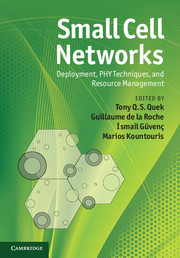Book contents
- Frontmatter
- Contents
- List of contributors
- Foreword by David Chambers
- Acknowledgments
- Acronyms
- 1 Small cell networks overview
- 2 Fundamentals of access control in femtocells
- 3 Coverage analysis using the Poisson point process model
- 4 Interference modeling for cognitive femtocells
- 5 Multiple antenna techniques in small cell networks
- 6 Physical layer techniques for cognitive femtocells
- 7 Femtocell coverage optimization
- 8 Random matrix methods for cooperation in small cell networks
- 9 Mobility in small cell networks
- 10 Cognitive radio resource management in autonomous femtocell networks
- 11 Decentralized reinforcement learning techniques for interference management in heterogeneous networks
- 12 Resource allocation optimization in heterogeneous wireless networks
- 13 New strategies for femto-macro cellular interference control
- 14 Femtocell interference control in standardization
- 15 Spectrum assignment and fairness in femtocell networks
- 16 Self-organization and interference avoidance for LTE femtocells
- Index
- References
10 - Cognitive radio resource management in autonomous femtocell networks
Published online by Cambridge University Press: 05 May 2013
- Frontmatter
- Contents
- List of contributors
- Foreword by David Chambers
- Acknowledgments
- Acronyms
- 1 Small cell networks overview
- 2 Fundamentals of access control in femtocells
- 3 Coverage analysis using the Poisson point process model
- 4 Interference modeling for cognitive femtocells
- 5 Multiple antenna techniques in small cell networks
- 6 Physical layer techniques for cognitive femtocells
- 7 Femtocell coverage optimization
- 8 Random matrix methods for cooperation in small cell networks
- 9 Mobility in small cell networks
- 10 Cognitive radio resource management in autonomous femtocell networks
- 11 Decentralized reinforcement learning techniques for interference management in heterogeneous networks
- 12 Resource allocation optimization in heterogeneous wireless networks
- 13 New strategies for femto-macro cellular interference control
- 14 Femtocell interference control in standardization
- 15 Spectrum assignment and fairness in femtocell networks
- 16 Self-organization and interference avoidance for LTE femtocells
- Index
- References
Summary
Introduction
Because of the use of common radio resources in small cell networks [1, 2], destructive interference may occur not only between the femtocell and the macrocell, but also among femtocells whose coverage areas are highly overlapped with each other (collocated femtocells), as shown in Figure 10.1. To avoid interference, one typical solution is to divide the entire available spectrum into several frequency bands, and then each femtocell and the macrocell utilize different frequency bands from each other [3]. This deployment is referred to as “dedicated channel” deployment in 3rd Generation Partnership Project (3GPP) [4]. However, the performance of this solution is limited by the assigned bandwidth, which makes it infeasible for dense femtocell deployments where each femtocell can only utilize a very limited fraction of the bandwidth. An alternative solution is to adopt spatial domain frequency reuse [5]; however, this is infeasible for user deployed femtocells without centralized and perfect planning. As a result, a practical solution turns out to be “co-channel” deployment, where all femtocells and the macrocell can utilize all the available spectrum. To mitigate interference in co-channel deployment, dynamic power adaptation in femtocells has been proposed for code division multiple access (CDMA) systems [6-11] to combat interference due to the near–far problem. Considering that orthogonal frequency division multiple access (OFDMA) has been adopted by 3GPP LTE-Advanced (LTE-A) and wireless interoperability for microwave access (WiMAX), new interference mitigation techniques are needed [12]. In OFDMA, the major cause of interference is that multiple networks occupy the same radio resources (subcarriers and orthogonal frequency division multiplexing (OFDM) symbols) simultaneously.
Information
- Type
- Chapter
- Information
- Small Cell NetworksDeployment, PHY Techniques, and Resource Management, pp. 246 - 259Publisher: Cambridge University PressPrint publication year: 2013
